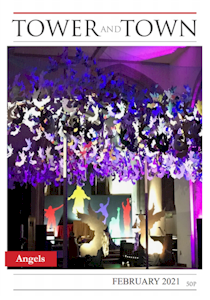

Tower and Town, February 2021 (view the full edition) (view the full edition)Our ButterfliesIn Madama Butterfly the heroine exclaims: "They say that overseas, if it falls into the hands of man, a butterfly is stuck through with a pin and fixed to a board!" This prophetic statement about her ultimate destiny is followed by the longest love duet in all of Puccini's operas. I can remember from my school days being shown trays of butterflies in the Biology Lab: now, in this conservation-minded era, we shudder at the thought. Putting my head out of the train window in the 1950's I would see clouds of butterflies along the sidings: Whites, Ringlets, Tortoiseshells and Hedge Browns galore. Sadly, it has been a story of declining numbers, a staggering ¾'s reduction in the last 50 years. There are about 58 species of butterfly on the U.K. list of which some 45 are recorded annually in Wiltshire, making it a good county for this varied and colourful insect. In the winter months we sometimes find a motionless Peacock or Small Tortoiseshell on a window-sill or an inside wall. The natural instinct is to open the window and let it out, but it isn't the right thing to do: put it in a cardboard box, place it in a dark corner of your garage and let it come to life in the spring. In those cool, sunny days in March and April the sight of the first Brimstone, a dainty Orange Tips or a motionless Red Admiral on a leaf gladdens the heart. We are lucky in Wiltshire to have several butterfly hotspots: Morgan's Hill Nature Reserve, the Calstone and Cherhill Downs, Ravensroost Wood and the Pewsey Downs. Despite the statement by Butterfly Conservation that the overall picture was poor in 2020, I was out in the field more than usual between lockdowns and my butterfly list was good: Holly Blues in the garden, Small Blues, Dingy Skipper, Dark Green Fritillaries, the beautiful Adonis Blue and many Marbled Whites on the downs and Small Heaths, Ringlets, Gatekeepers and Green-veined Whites in my local fields. Within a mile of Marlborough there were records of Marsh Fritillaries and even of Duke of Burgundy, a very special species which lepidopterists reverently call 'The Duke' In Savernake Forest in late July the search was on for the elusive Purple Emperor. I am told that some fanatics even smear one landmark with rotting fruit and worse things, to attract the beautiful males to feed there. I took a walk down one ride in August in the hope of seeing one. "You've just missed a male" a couple told me, "it perched on a metal gatepost back there... a few minutes ago!" Butterflies are on the wing so briefly and precariously in our beautiful county we should cherish them and seek to support their continued survival.  Robin Nelson |